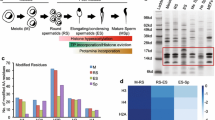Abstract
Background: The sperm chromatin is condensed by protamines in all mammals and many additional species. Protamines are small and extremely positively charged proteins (50–70% arginine), which are known to streamline the sperm cell and protect its DNA. In addition, it has also been shown in mammals that 2–10% of its mature sperm chromatin is also associated with a complex population of histones and chromatin-associated proteins differentially distributed in the genome. These proteins are transferred to the oocyte upon fertilization and may be involved in the epigenetic marking of the paternal genome and embryo development. However, little information is so far available on the additional potential sperm chromatin proteins present in other protamine-containing nonmammalian vertebrates, based on high-throughput mass spectrometry protein identification strategies.
Access provided by Autonomous University of Puebla. Download conference paper PDF
Similar content being viewed by others
Background: The sperm chromatin is condensed by protamines in all mammals and many additional species. Protamines are small and extremely positively charged proteins (50–70% arginine), which are known to streamline the sperm cell and protect its DNA. In addition, it has also been shown in mammals that 2–10% of its mature sperm chromatin is also associated with a complex population of histones and chromatin-associated proteins differentially distributed in the genome. These proteins are transferred to the oocyte upon fertilization and may be involved in the epigenetic marking of the paternal genome and embryo development. However, little information is so far available on the additional potential sperm chromatin proteins present in other protamine-containing nonmammalian vertebrates, based on high-throughput mass spectrometry protein identification strategies.
Main Questions: To characterize the proteome of the mature sperm of the European sea bass (Dicentrarchus labrax), a modern teleost fish chosen as a representative of protamine-containing nonmammalian vertebrate species, in order to determine whether its sperm chromatin also contains a complex population of histones and chromatin-associated proteins, similarly as it has been reported in mammals and some non-vertebrate species.
Experimental Design: Proteins were extracted from purified sperm cells and purified sperm nuclei and digested with trypsin. The peptides were separated using liquid chromatography (LC) and identified through tandem mass spectrometry (MS/MS). The criteria used for protein identification were ≥ 1 peptide per protein (at least one unique peptide) and an FDR of 1%.
Main Results: A total of 300 proteins have been identified. Of interest, 105 chromatin-associated proteins, of which nine are histone or histone variants, have been detected, in addition to the protamines. These results provide phylogenetically strategic information, indicating that the coexistence of histones, additional chromatin-associated proteins, and protamines in mature sperm is not exclusive of mammalian vertebrates, but it is also present in other protamine-containing vertebrate species. Additional novel aspects of the sperm structure and function are also identified through the comparative analysis of this sperm proteome together with that of other species.
Conclusions: The coexistence of histones and other chromatin-associated proteins in addition to protamines in the D. labrax mature sperm chromatin indicates that this complex composition is more conserved in vertebrates than previously thought. The availability of the sperm proteome also contributes to further functional insights of this cell.
Reference
Barrachina F, Anastasiadi D, Jodar M, Castillo J, Estanyol JM, Pifarrer F, Oliva R (2018) Identification of a complex population of chromatin-associated proteins in addition to protamines in the European sea bass (Dicentrarchus labrax) sperm. Sys Biol Reprod Med, 64:502–517. https://doi.org/10.1080/19396368.2018.1482383
Acknowledgments
Funded by Ministerio de Economia y Competitividad (MEC; PI13/00699, PI16/00346) and EUGIN-UB (2014), Generalitat de Catalunya (PERIS 2016-2020, SLT002/16/00337 to M.J.), Ministerio de Educación, Cultura y Deporte (FPU15/02306 to F.B.), and MEC (AES Sara Borrell, CD17/00109 to J.C.).Note: Subsequently to the oral presentation of the above communication in the XIIIth International Symposium on Spermatology in Stockholm, Sweden, the detailed results were published in the reference cited below to which the reader is referred for further information (Barrachina et al. 2018).
Author information
Authors and Affiliations
Corresponding author
Editor information
Editors and Affiliations
Rights and permissions
Copyright information
© 2021 Springer Nature Switzerland AG
About this paper
Cite this paper
Barrachina, F. et al. (2021). Complex Population of Chromatin-Associated Proteins Identified in Mature Sperm of the European Sea Bass (Dicentrarchus labrax) Through High-Throughput Proteomic Analysis. In: Björndahl, L., Flanagan, J., Holmberg, R., Kvist, U. (eds) XIIIth International Symposium on Spermatology. Springer, Cham. https://doi.org/10.1007/978-3-030-66292-9_9
Download citation
DOI: https://doi.org/10.1007/978-3-030-66292-9_9
Published:
Publisher Name: Springer, Cham
Print ISBN: 978-3-030-66291-2
Online ISBN: 978-3-030-66292-9
eBook Packages: Biomedical and Life SciencesBiomedical and Life Sciences (R0)




